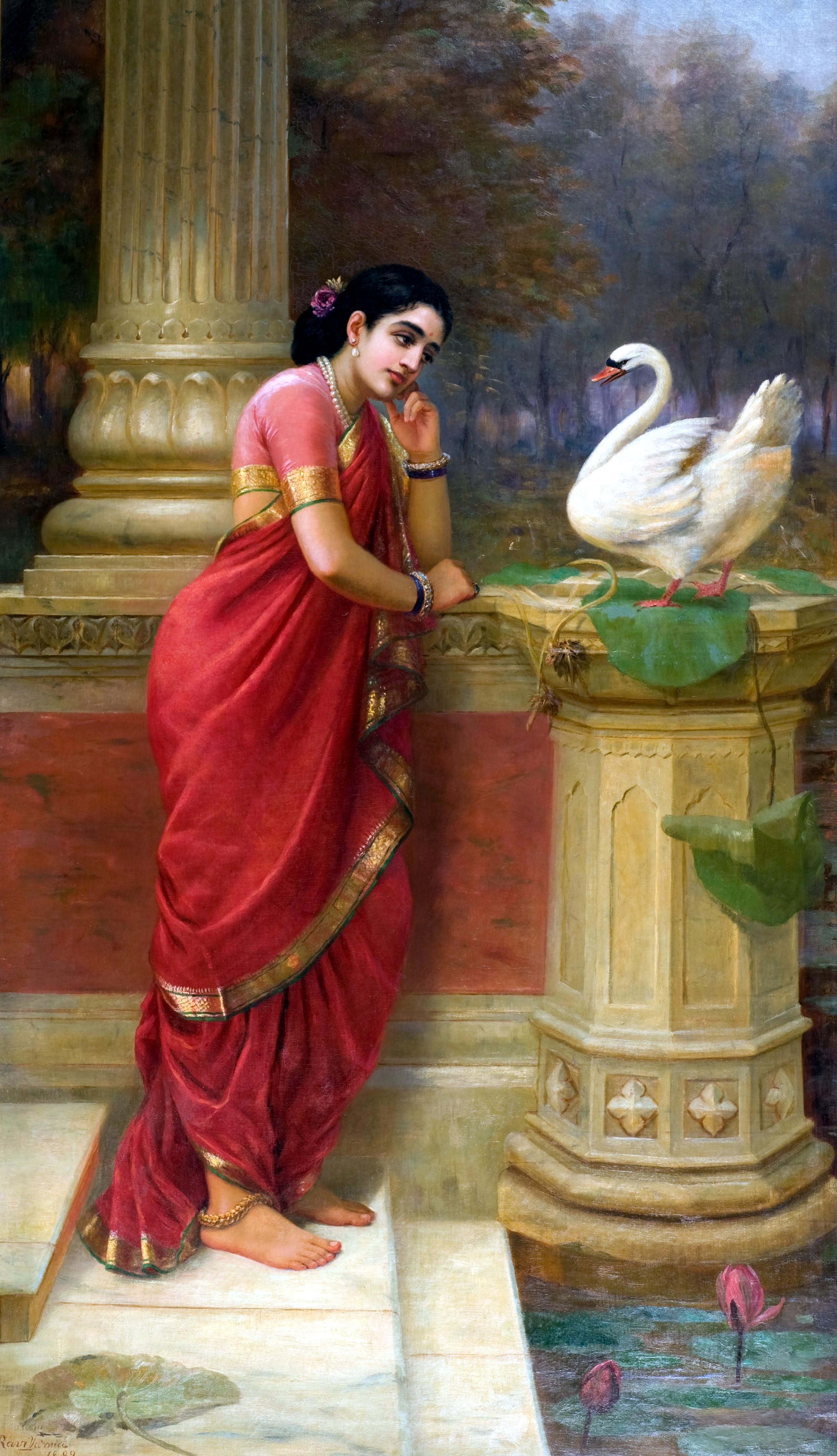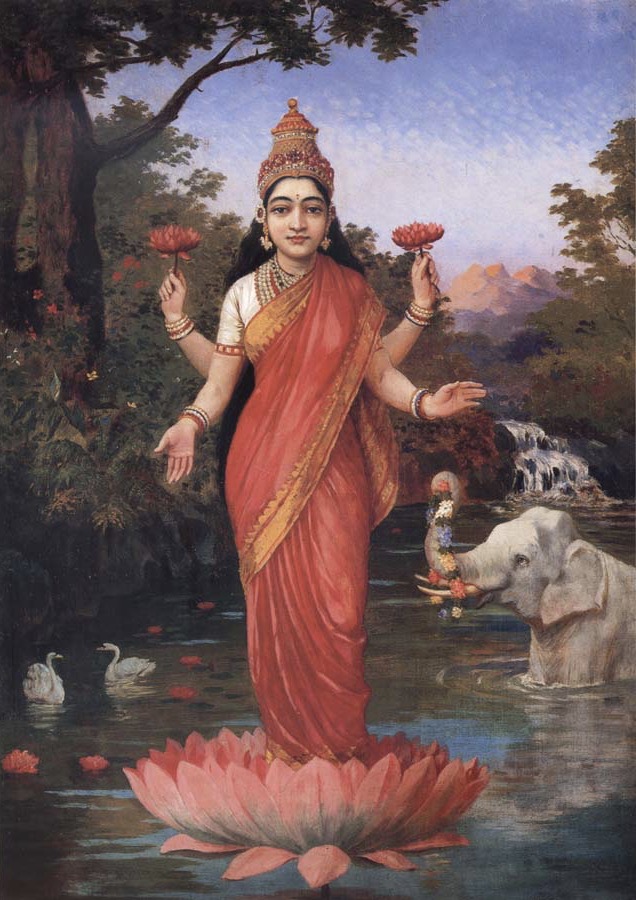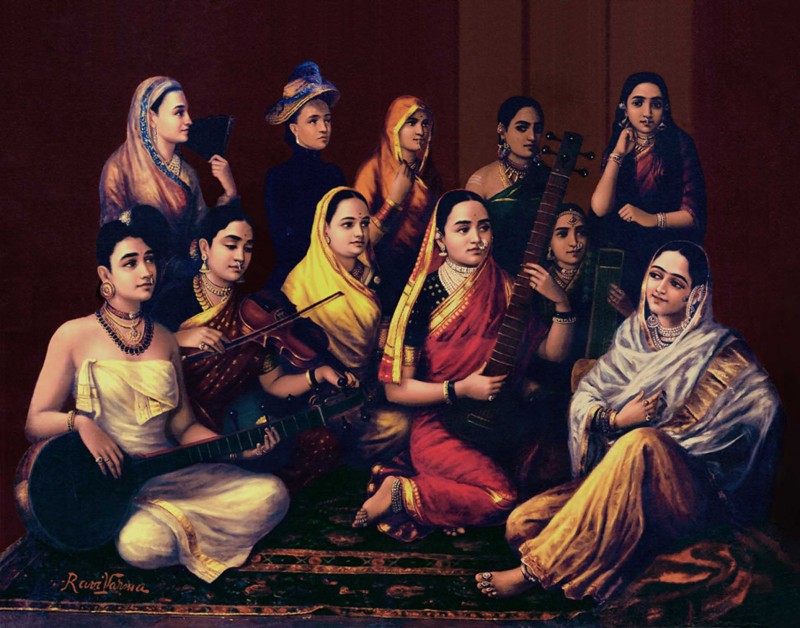 |
| Self portrait by Raja Ravi Varma Raja Ravi Varma, Public domain, via Wikimedia Commons {{PD-US}} |
Raja Ravi Varma (1848–1906) occupies a unique and irreplaceable place in the history of Indian art. At a time when India was in the throes of colonial domination, social reform, and cultural reawakening, Ravi Varma emerged as a painter who gave visual form to the stories, myths, and ideals that defined the Indian imagination.
His work represented an extraordinary synthesis: the grandeur of Indian mythological themes fused seamlessly with the techniques of European realism. This blend allowed him to create images that were at once deeply rooted in Indian tradition and universally accessible in their emotional appeal.
Ravi Varma’s canvas stretched wide across human experience. He painted the gods and goddesses of Hinduism with an intimacy that made them household figures. He brought the dramas of mythology and epic romance into relatable visual form, rendering characters like Shakuntala and Damayanti with human gestures and emotions.
His moral dramas carried allegories that resonated with the ethical struggles of colonial India. At the same time, he dignified everyday domestic life, portraying tender familial bonds that captured the aspirations of aristocratic and middle-class households. Beyond these, his works also envisioned cultural unity, celebrating India’s diversity through symbolic and inclusive representation.
The central idea that defines Ravi Varma’s legacy is this: he painted not just scenes and figures but the very way Indians came to imagine themselves, their divinities, and their nation. His art became a visual vocabulary for devotion, morality, love, and identity—one that endures even today.
Mythology and Epic Romance: Humanizing the Divine Narratives

Hamsa Damayanti
Raja Ravi Varma, Public domain,
via Wikimedia Commons
Damayanti and the Swan

Raja Ravi Varma, Public domain,
via Wikimedia Commons
Ravi Varma’s iconic painting, Damayanti and the Swan, masterfully translates epic grandeur into a moment of profound personal emotion.
The scene, drawn from the Mahabharata, captures the delicate princess Damayanti as she listens intently to a celestial swan. This divine messenger carries messages of love from Prince Nala.
Varma imbues the work with remarkable emotional intimacy. Damayanti’s soft blush, wide-eyed curiosity, and quiet dignity of her pose convey the first stirrings of love.
The swan, though a mythical creature, is rendered with striking realism, transforming it from a mere symbol into a tangible a symbol of communication and destiny.
The painting’s enduring appeal lies in how Varma made a legendary character deeply relatable, connecting the universal experience of love with divine narrative. The work stands as a testament to Varma's genius in bridging classical Indian mythology with a new, accessible form of artistic realism.
Shakuntala Looking Back
 |
| Shakuntala Looking Back Raja Ravi Varma, Public domain, via Wikimedia Commons |
Here, Ravi Varma captures the coy gestures of a woman in love—playful, modest, yet emotionally transparent. The figure is not presented as an aloof heroine of distant antiquity but as a woman whose emotions and body language resonate with ordinary viewers.
This subtle humanization of epic romance allowed audiences to engage with classical literature in ways that felt immediate and personal.
Analysis
Through these depictions, Ravi Varma bridged epic grandeur with human emotion. By emphasizing gestures, glances, and blushes, he brought mythological figures closer to ordinary human experience. He made the divine and legendary accessible, turning mythological characters into relatable human beings while retaining their aura of cultural significance. In doing so, he democratized access to epics, transforming them from distant stories into intimate experiences of love, longing, and destiny.
Gods and Goddesses: Democratizing Devotion

Goddess Lakshmi - Oil on Canvas
Raja Ravi Varma, Public domain,
via Wikimedia Commons
Lakshmi

Raja Ravi Varma, Public domain,
via Wikimedia Commons
Ravi Varma’s celebrated painting of Lakshmi, the goddess of wealth and prosperity, is a masterpiece of both artistic skill and cultural impact.
In this iconic image, she stands gracefully on a blooming lotus, her divine form radiating with a golden light. While her symbolism is rooted in traditional Hindu iconography, the striking realism of her figure sets this portrayal apart.
Varma captures her with lifelike posture, soft skin tones, and human proportions, making the goddess feel tangible and approachable. This unique blend of divine subject and realistic technique helped the image transcend its status as a mere painting.
Reproduced as oleographs, it entered countless Indian households, becoming a staple of domestic devotion. It served not only as a devotional icon but also as a powerful cultural emblem, symbolizing not just spiritual abundance but also the tangible hope of prosperity for the masses.
Saraswati
Similarly, his Saraswati portrays the goddess of wisdom, purity, and the arts. Holding a veena in her hands, adorned in a white sari, Saraswati embodies serenity and learning. Ravi Varma’s Saraswati is not a distant abstraction of knowledge but a graceful human figure radiating peace and focus. For generations of Indians, this image came to define what Saraswati looked like, fixing her iconography in popular imagination.
Krishna
Ravi Varma also painted Krishna in multiple moods—sometimes as a playful child adored by his mother, at other times as the enchanting lover surrounded by gopis. In these works, divinity is expressed not through overwhelming grandeur but through charm, tenderness, and intimacy. His Krishna is mischievous yet lovable, divine yet recognizably human in his emotional expressions.
Analysis
By giving gods and goddesses natural human form, Ravi Varma effectively democratized devotion. He moved away from stylized iconography toward figures that felt alive, familiar, and emotionally resonant. In doing so, he created a lasting visual vocabulary for Hindu worship. Even today, the popular images of Lakshmi, Saraswati, and Krishna that circulate in calendars, posters, and puja rooms owe their origins to Ravi Varma’s imagination. His contribution was not merely artistic—it was spiritual and cultural, shaping the very way Indians envision the divine.
Moral Dramas: The Canvas as a Stage for Ethical Reflection

Harischandra and Tharamathi
Raja Ravi Varma, Public domain, via
Wikimedia Commons {{PD-US}}
Harishchandra and Taramati

Raja Ravi Varma, Public domain, via
Wikimedia Commons {{PD-US}}
One of the most poignant themes Ravi Varma addressed was the story of Harishchandra, the truthful king who sacrifices everything—wealth, family, and comfort—for the sake of integrity.
In paintings like Harishchandra and Taramati, the anguish of sacrifice is palpable. The faces of the figures are suffused with emotional intensity: sorrow, endurance, and the heavy burden of moral choice.
Through their gestures and expressions, viewers feel the weight of truth and duty.
Broader Context
These moral allegories held particular resonance in colonial India. At a time when the nation grappled with questions of dignity, resistance, and identity under foreign rule, Harishchandra’s story of unbending truth acquired contemporary significance. It reminded viewers of the value of sacrifice and integrity in the face of suffering.
Analysis
Through such works, Ravi Varma transformed the canvas into a stage for ethical reflection. He made viewers not just admire the scene but also participate in the moral dilemma. The paintings became mirrors of conscience, inviting audiences to reflect on their own choices and responsibilities. This moral power gave his art a social and political relevance beyond aesthetic beauty.
Everyday Domesticity: Dignifying Family Life
 |
| There Comes Papa Raja Ravi Varma, Public domain, via Wikimedia Commons |
There Comes Papa
Not all of Ravi Varma’s art was mythological or moralistic. In There Comes Papa, he captures a tender domestic moment—a mother holding her child, both gazing expectantly at the father who remains unseen outside the frame.
The work dignifies ordinary family life, portraying emotional bonds with the same seriousness he accorded to gods and heroes.
Significance
This painting was revolutionary in its quiet way. By depicting aristocratic and middle-class households in such moments of affection, Ravi Varma elevated domesticity into the realm of fine art. He gave dignity to the rhythms of home life, showing that intimacy, anticipation, and affection were as worthy of artistic attention as mythology and morality.
Analysis
In highlighting everyday bonds, Ravi Varma broadened the scope of Indian art. He showed that the beauty of life lies not only in epic grandeur but also in the small, quiet gestures of family and love. His art thus captured the totality of human experience, from divine transcendence to domestic tenderness.
Cultural Unity: Visualizing a National Imagination

Galaxy of Musicians
Raja Ravi Varma, Public domain, via Wikimedia Commons
Galaxy of Musicians

Raja Ravi Varma, Public domain, via Wikimedia Commons
One of Ravi Varma’s most striking contributions to cultural imagination is Galaxy of Musicians.
In this painting, women from different regions of India are shown playing various musical instruments, each dressed in attire distinctive to her culture.
The composition celebrates diversity without fragmentation.
Symbolism
Music here becomes a metaphor for unity in diversity. Just as different instruments contribute to a single harmonious melody, different regions and traditions together compose the fabric of India. At a time of colonial fragmentation and political subjugation, this vision of cultural unity carried profound symbolic weight.
Analysis
The painting serves as a visual expression of a national imagination. Ravi Varma’s art reinforced cultural solidarity by reminding viewers that despite differences in attire, language, and custom, there was a deeper harmony binding the people of India together. His canvas became a site of proto-nationalist vision, preparing the ground for modern India’s sense of unity in diversity.
Technical Skill: Blending European Realism with Indian Aesthetics
 |
| Stolen Interview {{PD-US}} Raja Ravi Varma, Public domain, via Wikimedia Commons |
At the core of Ravi Varma’s genius was his technical ability to synthesize two seemingly divergent traditions. Trained in European realism, he mastered techniques of perspective, anatomy, shading, and oil painting.
Yet he applied these methods not to European subjects but to Indian themes. The result was a body of work that carried the tactile depth of realism while remaining deeply Indian in spirit.
His brushwork rendered fabrics, jewelry, and textures with meticulous detail. His use of light gave figures a three-dimensional presence. But what set him apart was his ability to infuse these technical elements with emotional resonance.
Every gesture, every expression, and every detail contributed to narrative meaning, making his works simultaneously technically impressive and emotionally powerful.
Lithographs: The Democratization of Art
Ravi Varma’s legacy was not confined to elite circles. Recognizing the power of mass dissemination, he pioneered the use of lithographs to reproduce his paintings. Through his printing press, his images of gods, goddesses, and mythological scenes entered countless homes across India.
For the first time, ordinary families could afford to own and worship images that had the aura of fine art. His lithographs made devotion accessible and brought aesthetic richness into everyday spaces. This democratization of art ensured that his influence extended far beyond palaces and galleries, seeping into the cultural consciousness of the masses.
Conclusion: Painter of India’s Cultural Consciousness
Raja Ravi Varma was not merely a painter; he was a cultural architect. His genius lay in his ability to wear multiple hats with equal ease: mythmaker, divine iconographer, moral dramatist, domestic chronicler, and national visionary. He humanized epic romances, democratized devotion by giving gods natural human form, reflected ethical dilemmas through moral dramas, dignified everyday domesticity, and envisioned cultural unity through symbolic works.
Technically, his art represented a remarkable synthesis of European realism and Indian aesthetics. Practically, his lithographs ensured that his vision reached every corner of the subcontinent. Symbolically, he shaped how Indians came to see their gods, their stories, their families, and their nation.
To this day, the enduring images of Lakshmi, Saraswati, Shakuntala, and Damayanti that populate India’s visual imagination are inseparable from Ravi Varma’s brush. He painted not only canvases but also the cultural consciousness of India. By bridging tradition and modernity, realism and symbolism, individuality and collective identity, Raja Ravi Varma secured his place as one of the most influential figures in Indian art history.
Appendix: References
-
National Museum of India archives
-
Raja Ravi Varma Heritage Foundation resources
-
Multiple scholarly articles and cultural history sources accessed online